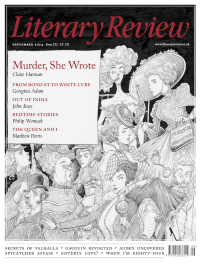Joseph Williams
Bad Blood
The Women Behind the Door
By Roddy Doyle
Jonathan Cape 272pp £20
Roddy Doyle can’t let Paula Spencer go. She first appeared in the four-part RTE drama Family (1994), played by Ger Ryan, before narrating the 1996 novel The Woman Who Walked into Doors, a dramatic monologue in which an alcoholic Dubliner looks back on her life following the death of her abusive husband, Charlo (the title refers to an excuse used to explain away a bruise). In Paula Spencer (2006), Paula, newly sober, navigates a changing Ireland. The Women Behind the Door sees Paula, now sixty-six and still haunted by the imagined ghost of Charlo, living through ‘the Covid’.
Despite the specificity of the setting, The Women Behind the Door is less a state-of-the-nation novel than a psychological portrait of a woman emerging from middle age. Paula admits (to us, at least) that she’s ‘a vain ol’ bitch’, but she is sensitive too. She is interested in words and naming. ‘Divorcee’, for instance, is ‘a great word, as sexy as fuck’. You will be aware that a group of starlings is a ‘murmuration’, but did you know that one of those little wine bottles is a ‘split’? How about the Japanese term ‘wise-man period’? (You can look that one up yourself.)
The plot gets moving fifty pages in, when Paula’s eldest, Nicola, herself a mother of three girls, turns up unannounced at her door. The dialogue is both fast and sharp (‘Serious as cancer,’ says one friend), and the speech is marked by em dashes, which lend the longer conversations pace

Sign Up to our newsletter
Receive free articles, highlights from the archive, news, details of prizes, and much more.@Lit_Review
Follow Literary Review on Twitter
Twitter Feed
It wasn’t until 1825 that Pepys’s diary became available for the first time. How it was eventually decrypted and published is a story of subterfuge and duplicity.
Kate Loveman tells the tale.
Kate Loveman - Publishing Pepys
Kate Loveman: Publishing Pepys
literaryreview.co.uk
Arthur Christopher Benson was a pillar of the Edwardian establishment. He was supremely well connected. As his newly published diaries reveal, he was also riotously indiscreet.
Piers Brendon compares Benson’s journals to others from the 20th century.
Piers Brendon - Land of Dopes & Tories
Piers Brendon: Land of Dopes & Tories - The Benson Diaries: Selections from the Diary of Arthur Christopher Benson by Eamon Duffy & Ronald Hyam (edd)
literaryreview.co.uk
Of the siblings Gwen and Augustus John, it is Augustus who has commanded most attention from collectors and connoisseurs.
Was he really the finer artist, asks Tanya Harrod, or is it time Gwen emerged from her brother’s shadow?
Tanya Harrod - Cut from the Same Canvas
Tanya Harrod: Cut from the Same Canvas - Artists, Siblings, Visionaries: The Lives and Loves of Gwen and Augustus John by Judith Mackrell
literaryreview.co.uk